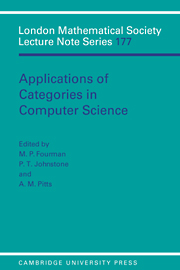 Applications of Categories in Computer Science
Applications of Categories in Computer Science Book contents
- Frontmatter
- Contents
- Preface
- Miscellaneous Frontmatter
- Computational comonads and intensional semantics
- Weakly distributive categories
- Sequentiality and full abstraction
- Remarks on algebraically compact categories
- Dinaturality for free
- Simply typed and untyped lambda calculus revisited
- Modelling reduction in confluent categories
- On clubs and data-type constructors
- Penrose diagrams and 2-dimensional rewriting
- Strong monads, algebras and fixed points
- Semantics of local variables
- Using fibrations to understand subtypes
- Reasoning about sequential functions via logical relations
- I-categories and duality
- Geometric theories and databases
- Partial products, bagdomains and hyperlocal toposes
I-categories and duality
Published online by Cambridge University Press: 24 September 2009
- Frontmatter
- Contents
- Preface
- Miscellaneous Frontmatter
- Computational comonads and intensional semantics
- Weakly distributive categories
- Sequentiality and full abstraction
- Remarks on algebraically compact categories
- Dinaturality for free
- Simply typed and untyped lambda calculus revisited
- Modelling reduction in confluent categories
- On clubs and data-type constructors
- Penrose diagrams and 2-dimensional rewriting
- Strong monads, algebras and fixed points
- Semantics of local variables
- Using fibrations to understand subtypes
- Reasoning about sequential functions via logical relations
- I-categories and duality
- Geometric theories and databases
- Partial products, bagdomains and hyperlocal toposes
Summary
Introduction
In recent joint work with A. Edalat[ES91] we developed a general approach to the solution of domain equations, based on information system ideas. The basis of the work was an axiomatization of the notion of a category of information systems, yielding what we may call an “information category”, or I-category for short. We begin this paper with an exposition of the I-category work. In the remainder of the paper we consider duality in I-categories, as the setting for studying initial algebra/final algebra coincidence. We then look at induction and coinduction principles in the light of these ideas.
To amplify the preceding a little, we note that the existing treatments of information systems, following [Sco82] and [LW84], make use of a global ordering of the objects of the category (the information systems) in order to “solve” domain equations by the ordinary cpo fixed point theorem. In the I-category approach, an initial algebra characterization of the solutions is obtained, by making use of a global ordering ⊆ of morphisms in addition to the ordering ⊴ of objects. (In the usual cases, where morphisms are “approximable relations” between tokens, the global ordering is essentially set inclusion; more precisely, we have that (f : A → B) ⊆ (f′ : A′ → B′) if A ⊴ A′, B ⊴ B′ and f ⊆ f′.) Moreover the axiomatic formulation enables us to handle many examples besides the usual categories of domains, in a unified manner: for example, “domain equations” over Stone spaces, via Boolean algebras as information systems. In the present exposition, we attempt to clarify the relation between the I-category approach and an established method of domain equation solution, namely the O-category method,usingthe Basic Lemma of [SP82] as a key.
- Type
- Chapter
- Information
- Applications of Categories in Computer ScienceProceedings of the London Mathematical Society Symposium, Durham 1991, pp. 270 - 287Publisher: Cambridge University PressPrint publication year: 1992
- 4
- Cited by


